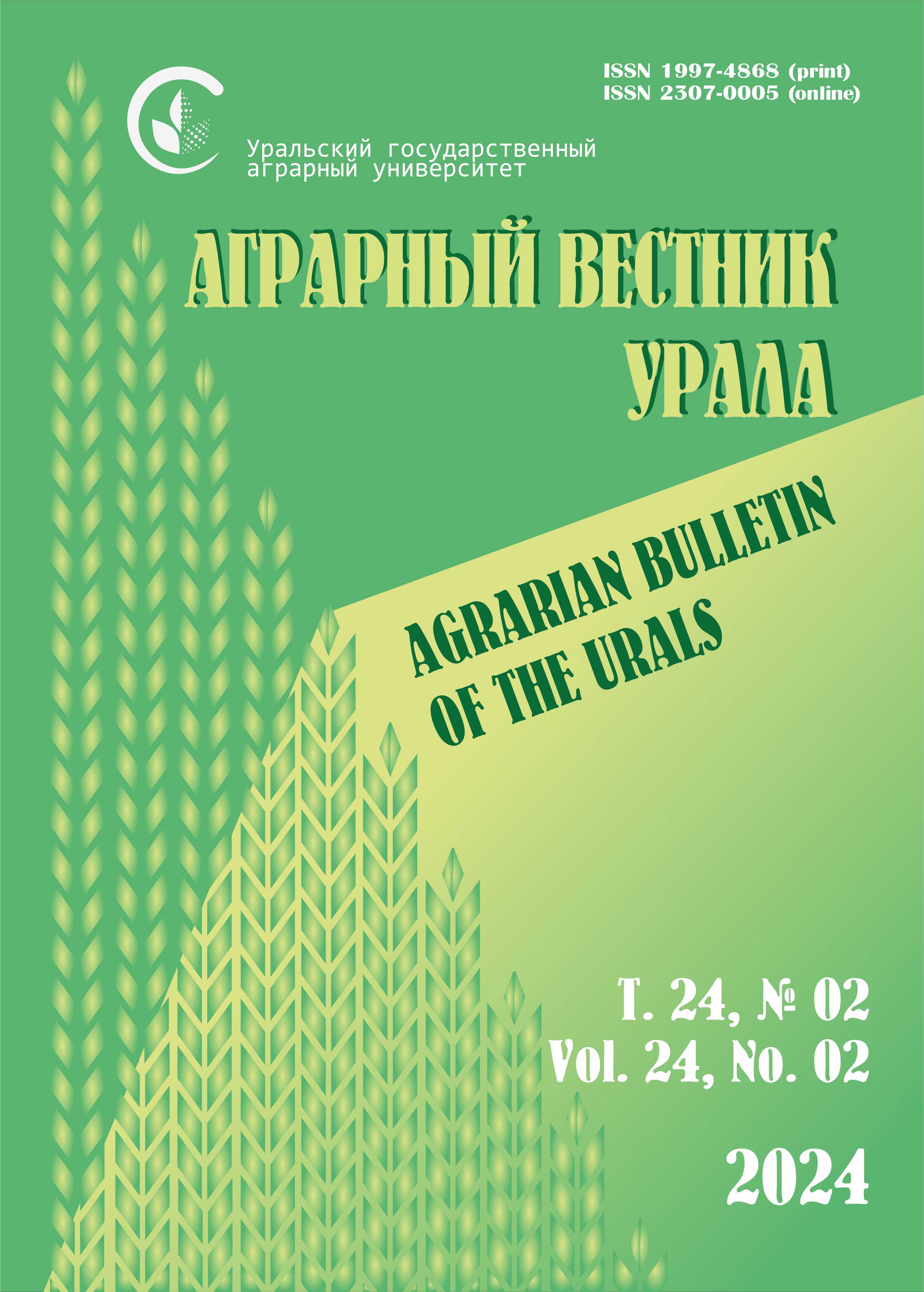Abstract. Currently, molecular genetic methods using DNA markers are increasingly used in studies of polymorphism of various populations of woody and shrubby plants. The purpose of this work was the evaluation and selection of protocols for the isolation and purification of DNA from the leaves of Gleditsia triacanthos L. for further studies using DNA labeling. Methods. Four protocols were used to isolate DNA from the leaf blade of Gleditsia triacanthos L. Anionic detergent sodium dodecyl sulfate was used in three isolation protocols for cell lysis, potassium acetate was used for purification from polysaccharides and proteins. In the fourth protocol, a cationic surfactant cetyltrimethyl ammonium bromide was used for cell lysis, the extract was purified with a mixture of chloroform-isoamyl alcohol (24 : 1). Precipitation of the isolated DNA was carried out with isopropanol. The quality of the isolated DNA was evaluated by spectrophotometry, horizontal electrophoresis and Real-time PCR with two types of primers. Results. Optimal conditions for DNA extraction from samples of Gleditsia triacanthos L. containing a large number of metabolites affecting the quality of the isolated extract were selected. By electrophoresis, it was found that both the isolation protocol with sodium dodecyl sulfate and the isolation protocol with cetyltrimethyl ammonium bromide make it possible to obtain a sufficient amount of DNA. The most purified DNA was obtained by the third protocol using sodium dodecyl sulfate and dithiotreitol and by the fourth protocol using cetyltrimethylammonium bromide. The results of PCR of the obtained samples with ITS and psbI-psbK primers indicate that a sufficient amount of product has been obtained and the reproducibility of ISSR markers. The scientific novelty of the work consists in choosing the optimal method of DNA extraction from the leaves of Gleditsia triacanthos L., which is a complex object containing a large number of potential PCR inhibitors. The protocol with sodium dodecyl sulfate and dithiotreitol made it possible to obtain DNA in the right amount and of acceptable quality.
DNA extraction, CTAB, sodium dodecyl sulfate, Gleditsia triacanthos, molecular markers
1. Kulakov E. A., Vorob'eva E. A., Sivolapov V. A., Karpechenko N. A. Ocenka polimorfizma duba chereshchatogo (Quercus robur) s pomosch'yu SSR-analiza // Lesnoy vestnik. 2021. T. 25. № 4. S. 44-51. DOI:https://doi.org/10.18698/2542-1468-2021-4-44-51. EDN: https://elibrary.ru/CORJOY
2. Tarakanov V. V., Palenova M. M., Parkina O. V. Rogovcev R. V., Tret'yakova R. A. Lesnaya selekciya v Rossii: dostizheniya, problemy, prioritety (obzor) // Lesohozyaystvennaya informaciya. 2021. № 1. S. 100-143. DOI:https://doi.org/10.24419/LHI.2304-3083.2021.1.09. EDN: https://elibrary.ru/DXAWDG
3. Kamnev A. M., Antonova O. Yu., Dunaeva S. E., Gavrilenko T. A., Chuhina I. G. Molekulyarnye markery v issledovaniyah geneticheskogo raznoobraziya predstaviteley roda Rubus L. i perspektivy ih primeneniya v selekcii // Vavilovskiy zhurnal genetiki i selekcii. 2020. T. 24. № 1. S. 20-30. DOI:https://doi.org/10.18699/VJ20.591. EDN: https://elibrary.ru/ULSFXC
4. Younis A., Ramzan F., Ramzan Y. et al. Molecular Markers Improve Abiotic Stress Tolerance in Crops: A Review // Plants. 2020. No. 9 (10). DOI:https://doi.org/10.3390/plants9101374.
5. Li A., Ma M., Li H., He S., Wang S. Genetic Diversity and Population Differentiation of a Chinese Endangered Plant Ammopiptanthus nanus (M. Pop.) Cheng f. // Genes. Vol. 14. No. 5. Article number 1020. DOI:https://doi.org/10.3390/genes14051020. EDN: https://elibrary.ru/HMWVUJ
6. Kornienko V. O., Kalaev V. N. Ekologo-morfologicheskie i biomehanicheskie osobennosti Gleditsia triacanthos L. v usloviyah antropogennogo zagryazneniya goroda Donecka // Vestnik VGU. Seriya: Himiya. Biologiya. Farmaciya. 2018. № 2. S. 143-151. EDN: https://elibrary.ru/XUWIMP
7. Adamova R. M., Kaziev M.-R. A. Ekologo-biologicheskie aspekty formirovaniya zaschitnyh lesnyh nasazhdeniy v aridnyh rayonah // Aridnye ekosistemy. 2021. № 2 (87). C. 26-32. DOI:https://doi.org/10.24411/1993-3916-2021-10147. EDN: https://elibrary.ru/GOVIPK
8. Li J., Ye C. Genome-wide analysis of microsatellite and sex-linked marker identification in Gleditsia sinensis // BMC Plant Biology. 2020. Vol. 20 (1).Article number 338. DOI:https://doi.org/10.1186/s12870-020-02551-9. EDN: https://elibrary.ru/KEATNE
9. Sal'nikova N. A., Samotrueva M. A., Konovalov D. A. Himicheskiy sostav i farmakologicheskie svoystva rasteniy roda Gleditsia L. (obzor literatury) // Kurskiy nauchno-prakticheskiy vestnik «Chelovek i ego zdorov'e». 2019. № 3. S. 87-96. DOI:https://doi.org/10.21626/vestnik/2019-3/12. EDN: https://elibrary.ru/OSCKUT
10. Inglis P. W., Pappas M. R., Resende L. V., Grattapaglia D. Fast and inexpensive protocols for consistent extraction of high quality DNA and RNA from challenging plant and fungal samples for highthroughput SNP genotyping and sequencing applications Plant Genetics Laboratory // PLOS ONE. 2018. Vol. 13. No. 10. Article number e0206085. DOI:https://doi.org/10.1371/journal.pone.0206085.
11. Islam M. S., Aryasomayajula A., Selvaganapathy P. R. A review on macroscale and microscale cell lysis methods // Micromachines. 2017. Vol. 8. Iss. 3. Article number 83. DOI:https://doi.org/10.3390/mi8030083.
12. Popova A. A., Grodeckaya T. A., Molchanov V. V, Evlakov R. M. Podbor i optimizaciya metodov ekstrakcii DNK iz razlichnogo rastitel'nogo materiala // Vestnik PGTU. Seriya: Les. Ekologiya. Prirodopol'zovanie. 2022. № 1 (53). S. 69-76. DOI:https://doi.org/10.25686/2306-2827.2022.1.69. EDN: https://elibrary.ru/PRPCKP
13. Il'nickaya E. T., Makarkina M. V., Tokmakov S. V., Naumova L. G. DNK-markernaya identifikaciya lokusa ustoychivosti k mild'yu Rpv10 v genotipah vinograda // Vavilovskiy zhurnal genetiki i selekcii. 2023. № 2 (27). C. 129-134. DOI:https://doi.org/10.18699/VJGB-23-18. EDN: https://elibrary.ru/BGNXCP
14. Barbier F. F., Chabikwa T. G., Ahsan M. U. et al. A phenol/chloroform-free method to extract nucleic acids from recalcitrant, woody tropical species for gene expression and sequencing // Plant Methods. 2019. No. 15. Pp. 62-74. DOI:https://doi.org/10.1186/s13007-019-0447-3. EDN: https://elibrary.ru/GOFLBL
15. Ahmadi E., Kowsari M., Azadfar D., Jouzani G.S. Rapid and economical protocols for genomic and metagenomic DNA extraction from oak (Quercus brantii Lindl.) // Annals of Forest Science. 2018. Vol. 75. Article number 43. DOI: 10.1007 /s13595-018-0705-y. DOI: https://doi.org/10.1007/s13595-018-0705-y; EDN: https://elibrary.ru/YHIYEP
16. Petrov D. G., Makarova E. D., Germash N. N., Antifeev I. E. Metody vydeleniya i ochistki DNK iz lizatov kletok (obzor) // Nauchnoe priborostroenie. 2019. T. 29. № 4. S. 28-50. DOI: https://doi.org/10.18358/np-29-4-i2850; EDN: https://elibrary.ru/CSYOEC
17. Guchetl' S. Z., Zolotavina M. L., Grigor'yan A. A., Golovatskaya A. V. Issledovanie kachestva DNK dlya polimeraznoy cepnoy reakcii, ekstragirovannoy raznymi sposobami iz podsolnechnika // Maslichnye kul'tury. 2021. Vyp. 1 (185). S. 32-42. DOI:https://doi.org/10.25230/2412-608H-2021-1-185-32-42. DOI: https://doi.org/10.25230/2412-608X-2021-1-185-32-42; EDN: https://elibrary.ru/PHUUQI
18. Pencakowski B. M., Tokarski M., Jonkisz A., Czosnykowska-Łukacka M., Lenard E., Małodobra-Mazur M., Pencakowski B. M. et al. DNA profiling of oaks (Quercus spp.) // Archiwum Medycyny Sądowej i Kryminologii. 2018. Vol. 68. No. 1. DOI:https://doi.org/10.5114/amsik.2018.75942.
19. Zhang Y., Song M., Li H., Sun H., Zhang Z. DNA barcoding identification of original plants of a rare medicinal material Resina Draconis and related Dracaena species // Zhongguo Zhong Yao Za Zhi. 2021. Vol. 46, No. 9. Pp. 2173-2181. DOI:https://doi.org/10.19540/j.cnki.cjcmm.20210124.104.









